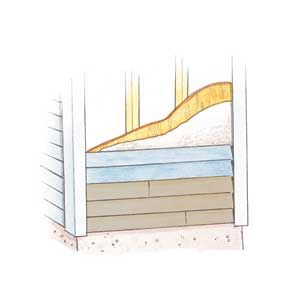
Water-damaged siding is a significant concern, causing homeowners to understandably fear extensive and costly repairs. However, in many cases, the damage is more limited than you might think, and repairs are pretty manageable with the right approach. This guide walks you through the process of identifying, assessing, and repairing water-damaged siding, plus tips for preventing future issues.
Common Causes of Water Damage on Siding
Several factors can contribute to water damage in your home’s siding:
- Heavy rainfall and frequent storms
- Improper drainage around the house
- Lawn sprinklers consistently saturating your siding
- Shrubs growing too close to your house, limiting air circulation
- Incorrect siding installation, such as overdriven nails or improperly sealed joints
- Cut edges of siding placed too close to the ground
Signs of Water-Damaged Siding
Water-damaged siding typically shows up with soft or spongy areas with visible mold or mildew growth. Sometimes, you’ll also see siding panels warping or buckling, along with peeling paint or discoloration. In severe cases, you might even see water stains on your interior walls.
Inspecting Siding for Water Damage
Conduct a thorough inspection of your siding, paying close attention to the following:
- The bottom three courses of siding (about 2 feet up from the ground)
- Wood-framed chimneys or chases not protected by roof overhangs
- Areas around windows and doors
- Joints between siding panels
Determining If Siding Replacement Is Necessary
In some cases, a repair may not be enough, and a replacement might be necessary. Consider replacement if the damage extends beyond the siding into the sheathing or framing or if it affects large sections of your siding. Additionally, if your siding is outdated, you might not be able to find an exact match. In that case, we recommend updating your home’s siding altogether.
Tools and Materials To Repair Siding
To repair water-damaged siding, you’ll need these tools and materials:
- Pry bar
- Hammer
- Utility knife
- Circular saw
- Caulking gun
- Replacement siding panels
- Nails
- Building paper or housewrap
- Exterior-grade caulk
- Paint and primer (if necessary)
Step 1: Remove the Damaged Siding
Start at the top of the damaged area and work your way down. Use a pry bar to carefully remove the nails and separate the damaged siding from the wall. Cut out the damaged sections using a utility knife or circular saw.
Step 2: Address the Underlying Issues
Inspect the sheathing and framing for any water damage or rot. Replace any damaged structural elements. Apply a new layer of building paper or housewrap to protect against future water infiltration.
Step 3: Install the New Siding
Cut the new siding to fit the repaired area. Install the new siding panels, starting from the bottom and working up. Nail the siding securely, being careful not to overdrive the nails. Caulk any joints or seams to prevent water penetration. Paint the new siding to match the existing color, if necessary.
Preventing Future Water Damage
Proper installation and regular maintenance are key factors to keep your siding in good condition and prevent further issues.
Proper Siding Installation Techniques
Install your siding correctly to make sure it doesn’t get damaged again. Keep proper clearance between your siding and the ground (at least 6 inches for most materials), and add in the correct flashing around windows, doors, and other openings.
Lastly, seal all the joints and seams properly. Only then are you ready to install the new siding over your water-resistant barrier.
Regular Maintenance Tips
- Clean gutters and downspouts regularly to prevent water overflow.
- Trim shrubs and trees away from the house to improve air circulation.
- Adjust sprinklers to avoid directly spraying siding.
- Inspect siding annually for signs of damage or wear.
- Repaint or reseal siding as needed to maintain its protective qualities.
When To Call a Professional to Repair Water-Damaged Siding
While many siding repairs can be DIY projects, there are times when it’s best to call in a professional. Knowing when to seek expert help can save you time, effort, and potentially further damage to your home. Call a professional in these circumstances:
- If the damage extends into the structural elements of your home, such as the frame
- When dealing with large areas of damage
- If you’re unsure about the extent of the damage or proper repair techniques
- When working with specialized siding materials that require expert handling
Professional contractors have the experience and tools to assess and repair water damage better than the average homeowner.
Our Conclusion
Water damage to siding is a common problem in homes. With proper assessment and repairs, most homeowners can fix this issue themselves. Once you figure out what caused the water damage, you can repair it and prevent it from happening again.
The key to a successful repair is identifying signs early and taking preventive measures. Remember, you can likely repair small issues on your own, but we recommend hiring a professional for more extensive damage or if you’re not confident about the repair process.
